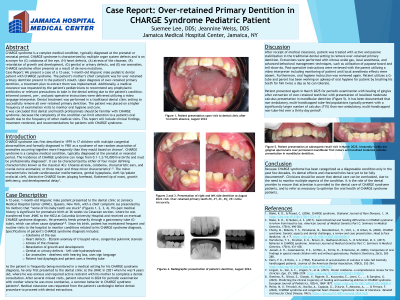Syndromes/Craniofacial Anomalies
323 - Over-retained Primary Dentition in CHARGE Syndrome Pediatric Patient


Suemee Lee, DDS
Pediatric Dental Resident PGY-1
Jamaica Hospital Medical Center
University of Minnesota
Long Island City, New York, United States- JW
Jeannine L. Weiss, Board Certified Pediatric Dentist (American Academy of Pediatric Dentistry)
program director and clinical faculty
Jamaica Hospital Medical Center, Department of Dental Medicine, Division of Pediatric Dentistry
Jamaica, New York, United States
Presenting Author(s)
Program Director(s)
CHARGE syndrome is a complex medical condition, typically diagnosed at the prenatal or neonatal period. CHARGE syndrome is characterized by multiple organ system defects, and is an acronym for (C) coloboma of the eye, (H) heart defects, (A) atresia of the choanae, (R) retardation of growth and development, (G) genital or urinary defects; and (E) ear anomalies. CHARGE syndrome often presents as a result of de novo mutations.
It was concluded that dental and health professionals should be familiar with CHARGE syndrome, because the complexity of the condition can limit attention to a patient's oral health due to the frequency of other medical visits. This report will include clinical findings, treatment rendered, and recommendations for patients with CHARGE syndrome.
Case Report: We present a case of a 12-year, 1-month-old Hispanic male pediatric dental patient with CHARGE syndrome. The p</span>atient’s mother’s chief complaint was for over-retained primary dentition present in the patient’s mouth. Upon diagnosis of over-retained primary dentition, a treatment plan to extract them was implemented. Additionally, a medical clearance was requested by the patient's pediatricians to recommend any prophylactic antibiotics or relevant precautions to take in the dental setting due to the patient's condition. Informed consent, pre-, and post-operative instructions were delivered utilizing a video language interpreter. Dental treatment was performed in a traditional dental clinic setting to successfully remove all over-retained primary dentition. The p</span>atient was placed on a higher frequency of examination visits to monitor oral hygiene and care.
Identify Supporting Agency and Grant Number:

.jpg)